Poaceae
Also knwon as Gramineae or Grass Family.
Herbs (except bamboos, which can be woody shrubs or trees).
- Flowers (florets) perfect or imperfect, consisting of two bracts (the lemma and palea), usually 3 stamens, a single pistil. Pistil compound (only one ovule), ovary superior.
- Fruit a caryopsis (grain).
- Leaves long with parallel venation. Stems typically round and hollow.
- About 500 genera and 9,000 species, worldwide.
The grass family is the 2nd largest in B. C., with 334 taxa.
The grass family is probably the most important of all economically, providing hay and forage for domestic animals, bamboo, sugar (Saccharum), and grain: Zea (maize or corn), Triticum (wheat), Hordeum (barley), Avena (Oats), Secale (rye), and others. In addition, millions of hectares of grass are cultivated for lawns and golf courses. Finally, some of the worst weeds are grasses.
Wheat
| Most of the wheat grown in the world is bread wheat (Triticum aestivum). |
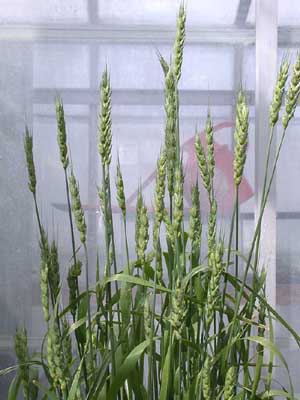 Wheat Plant |
| The flowers like most grasses are small and inconspicuous. they are not designed to attract pollinators, but instead rely on the wind to spread pollen from one plant to another. |
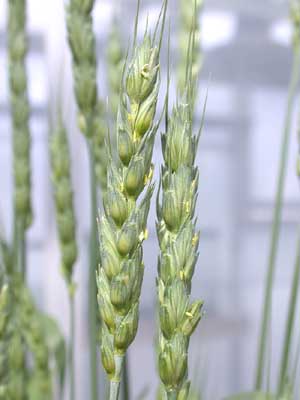 Bread wheat, Flowers |
| The reproductive parts of the grasses are very small. Here you can see the very feathery (plumose) stigma. The anthers are also pictured here. |
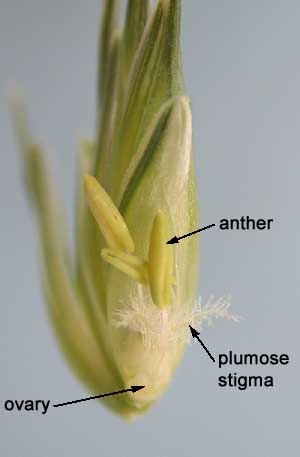 Grass, Reproductive Parts |
| The ovary of the pistil becomes the grain of wheat. |
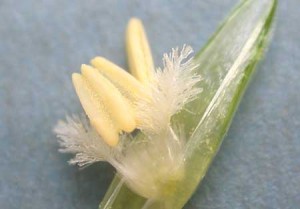 Triticum aestivum, Reproductive Part, Close Up |
Barley
| Barley (Hordeum vulgare) can be grown over a wide ecological range. There are a number of barley products: grain, hay, straw. Barley is also in the production of beer and whiskey. We explore these applications in Unit 4. |
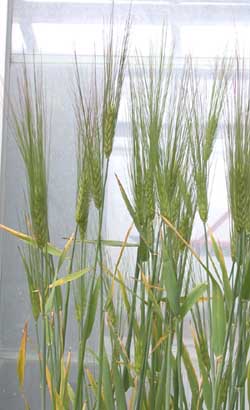 Hordeum vulgare, Barley Plant |
| In the picture to the right, you can see the anthers dangling down from the floret to catch the pollen in the wind. |
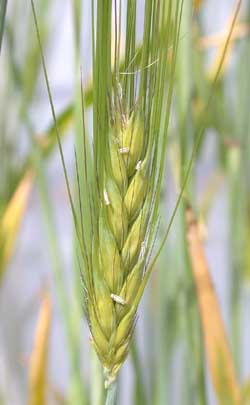 Barley, Inflorescence |
Oats
| Oats (Avena sativa) are mostly eaten as a breakfast food….or in cookies. Most of the world’s oats actually is used to feed livestock. |
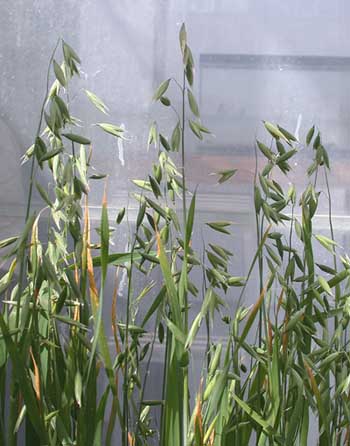 Oats Plant |

Oats, Inflorescence
| Here are some grains (fruits) of oats. Rolled oats are processed by first cleaning and then removing the outer casing (hull). The hull-less oats are now called groats. They are cut into tiny pieces and then are steamed and then passed through rollers. voila….rolled oats. |
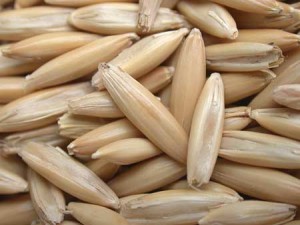 Grains (fruits) of Oats |
| A grain has been cut in half. You can see the embryo which is made up of the cotyledon, epicotyl, and the radicle (the hypocotyl is too small to label at this stage). another word for the embryo of the seed is the germ. when you buy germ at the store you are actually purchaing embryos.The hull has not been removed from this grain. When the hull is removed there is an outer skin to the grain; thiis is the bran. It is made up of thick-walled lignified cells so it is an excellent source of fibre. the endosperm is the food reserve of the seed. It provides ennergy to the developing seedling. When grains are milled for flour it is the endosperm that is processed (unless you get wholegain flours). |
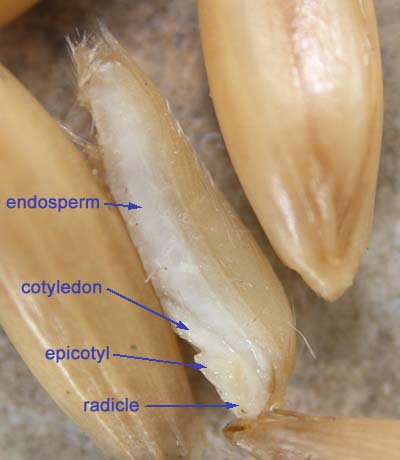 Oat Grain, Cut in Half |
Corn
| Corn (Zea mays) was probably the most important crop developed in the Americas. It was an important part of the belief systems of many of the meso- and South American First Peoples. It figures prominently to the lives of the people of Mexico to this day as the artwork below attests. You cannot have a Mexican meal without some form of corn whether it be a tortilla, a taco, or a tamale. |
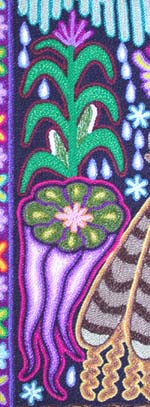 Native Art work |
| An ear of corn is a collection of female flowers. The fine strands called silks are the stigmas of the pistils. They wave in the wind to retrieve the pollin that is being blown in the air. |
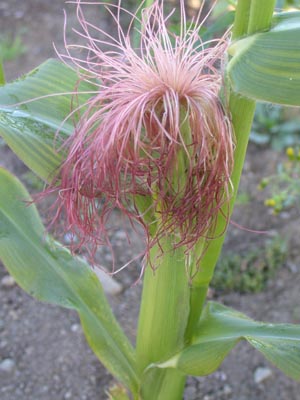 An Ear of Corn |
| Each kernel develops from an ovary. |
 Corn Kernels |
| In the picture below you can see the stigma atttached to the enlarged ovary. Within that ovary there is one seed. the seed coat is fused to the ovary wall. this type of fruit is called a grain. |
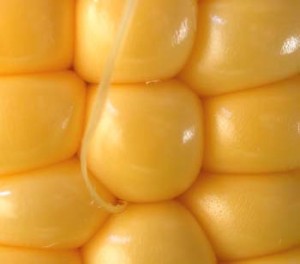 Kernels, Close Up |
| As with other members of the Poaceae each fruit contains one embryo. If you have every eaten canned corn you probably noticed the small bits left behind in the bottom of the can. These are embryos. You can also see the light-coloured embryoes when looking at the kernel (indicated with an arrow in the figure below). The rest of the kernel is made up of endosperm. |
 Individual Corn Kernel |
| The longitudinal section through the dernel of corn pictured below shows the different features. Parts of the embry include the cotyledon (C), the first foliage leaf (D), the shoot apical meristem (E), and the root apical meristem (F). The letter “G” represents the parts of the embryo that will give rise to the new plant. The cotyledon of this plant does not look leaf-like (as it did in the bean). Its function is to absprb the nutrients from the endosperm and transmit them to the rest of the embryo. It withers away shortly when the endosperm is depleted. |
 Longitudinal Section Through a Corn Kernel |
| Here is germinating corn kernel. You can see the root emerging toward the lower side of the grain while the young shoot is growing upward. |
 Germinating Kernel |
| Cornstarch is used as as a thickening agent, but did you know that it is what corn syrup is made from? Cornstarch is hydrolyzed using acids and enzymes to ultimately produce fructose. This sweetener is now used to sweeten most soda pops as well as many jams and ketchups. |
 Corn Starch |
Other Members of the Poaceae
RICE
| Oryza sativa is the major cultivated species, but there are others as well. Rice is the second most important staple food crop in the world. Improved processing methods, removal of the bran and embryo, have resulted in the decrease in nutritive value of the grain and malnourishment (beriberi) is common. The ancient practice of parboiling (boiling and steaming) before processing allows some of the nutrients from the bran and embryo to leach into the endosperm, making it more nutiritous. The picture below is what rice looks like after harvest, hull and all. |
 Rice |
| Wildrice, Zizania aquatica, as its name implies is an aquatic grass native to northeastern North America. Processing of this grain includes heating which gives it a “nutty” flavour. Wild rice is the most recent grass domestication (1970s). It is one of the most nutritious grains. |
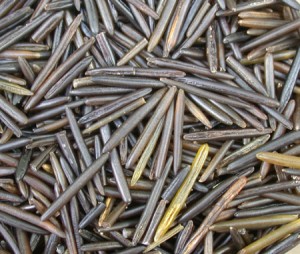 Wild Rice |
BAMBOO
| There are many species of bamboo. The young succulent shoots are popular in Asian cuisine. As the shoots elongate and mature, fibres of the vascular bundles mature to produce strong stalks. These bamboo canes are used for many things from cooking implements to building scaffolding. |
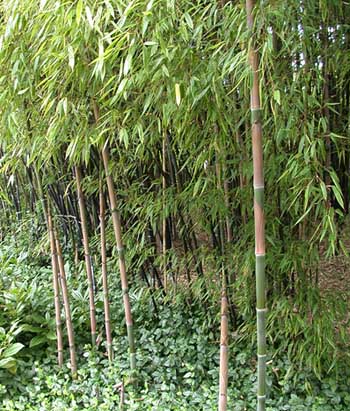 Bamboo Plant |
SUGAR CANE
|
Sugarcane (Saccharum officinalis) is a tall grass from which sugar (sucrose) is extracted. It is grown all over the world especially in the tropics. It was about 1000 years ago when cane sugar was first first produced in India. It is grown on rich rich soils like the lava soils of this region in Mexico.
Cane extracts are not only ussed to make sugar, but it is also important in the production of alcoholic beverages such as rum |
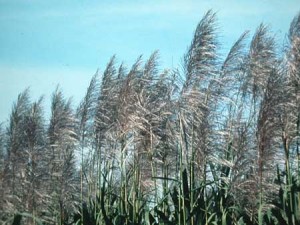 Sugarcane |
| Sugar cane can be eaten as a treat as well. |
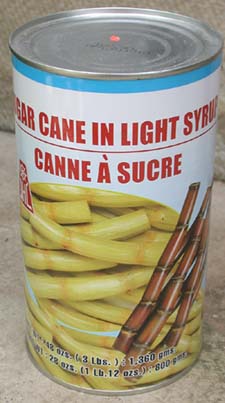 Sugar Cane Syrup |
Back to Lab 5























